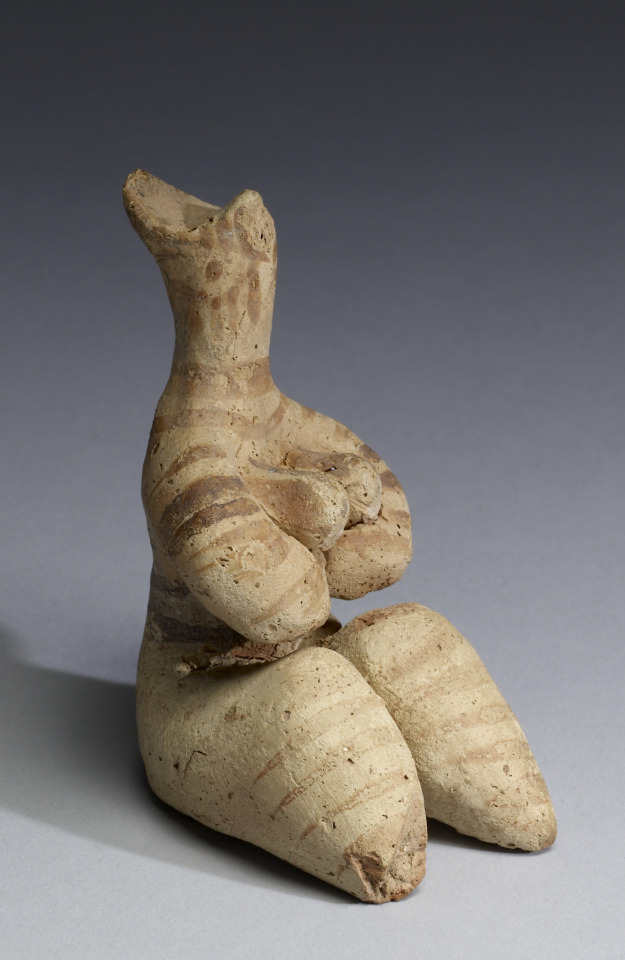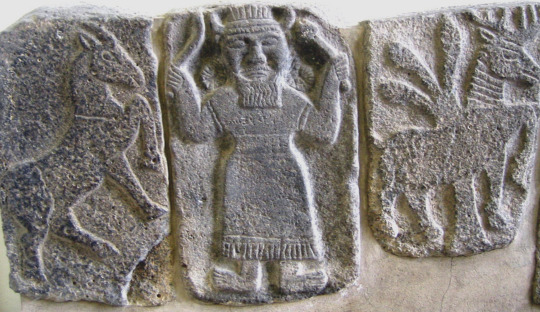#Tell Halaf
Explore tagged Tumblr posts
Text

Figures (Gods?) Standing on Bulls and Lions Late Hittite Tell Halaf, Syria c. 900 BCE
Housed in the Syria-Aleppo Museum
Source: https://www.hittitemonuments.com/
#syrian gods#hittite gods#aramean gods#aram#aramea#syria#syrian#tell halaf#syrian costume#hittite costume#polytheism#lion#bull#sphynx#lamassu
331 notes
·
View notes
Text

Halaf culture ( 6100 BC and 5100 BC.) prehistoric period , They have very cool Stamp seals, mostly geometric. Many Halafian settlements were abandoned around 5000 BC , and the remaining ones showed Ubaidian characters. I gave them traits of the Anu (An), God of the sky in Sumerian Mythology!
Samarra culture (5500 and 4800 BCE.) is a Late Neolithic archaeological culture of northern Mesopotamia! The culture is primarily known for its finely made pottery decorated with stylized animals, including birds, and geometric designs on dark backgrounds. I gave them traits of Ki, the Godess of Earth in sumerian mythology! Sumerian Mythology inspired many religions!!
The Epic of Gilgamesh (c. 2100–1800 BCE) references an early flood myth!

This is Read as An-Ki (Sky-Eath) It indicates the set of opposites, the still formless universe, composed of the names of the two gods An and Ki! The Epic tells of a the separation of the sky and eath , reminds me of the Pangu myth for China but also the Genesis , I find it pretty cool ! :D Here's the map of the general zones of where they were :

Sumerian Civilization (Sumer) , I've decided to make them the continuation of the Uruk period and before that of the Ubaid period. I also decide to give them the charetteristics of Gilgamesh still, a historical/mythical king of the Sumerian city-state of Uruk! (Ubaid Period 5500 – c. 3700 BC)->(Uruk Period 4000–3100 BC)->(Sumerian Civilization! that is from 5500 – c. 1800 BC)

Elam was an ancient civilization centered in the far west and southwest of Iran. I've decided to give them the traits of Enkidu, wartime comrade and friend of Gilgamesh!
The main division of Elam in time is as follows: (wiki)
Proto-Elamite: c. 3200 – c. 2700 BC (Proto-Elamite script in Susa) Old Elamite period: c. 2700 – c. 1500 BC (earliest documents until the Sukkalmah Dynasty) Middle Elamite period: c. 1500 – c. 1100 BC (Anzanite dynasty until the Babylonian invasion of Susa) Neo-Elamite period: c. 1100 – 540 BC (characterized by Assyrian and Median influence. 539 BC marks the beginning of the Achaemenid period.)

Akkadian Empire was the first known empire succeeding the long-lived city-states of Sumer, it was centered on the city of Akkad

Decided to base them on the bull of Heaven , a mythical beast fought by the King of Uruk Gilgamesh. (The Bull was identified with the constellation Taurus)
"The gods, particularly Ishtar, were angered by Enkidu and Gilgamesh's actions, including killing the Bull of Heaven and rejecting Ishtar's affections."
I've not followed the Epic exactly since a parallele can't be exactly be made between the characters and the civilizations, also because Sumer dissapears before Elam, so I effectevly inverted the roles with them ;v; Songs about the myth for anyone intrested:
GILGAMESH LAMENT FOR ENKIDU
Lament For GILGAMESH, The Gold Lyre Of Ur


Babylonia (1890 BC–539 BC) was an ancient Akkadian-speaking state and cultural area based in the city of Babylon in central-southern Mesopotamia I gave them Lion traits fro the Lion of Babylon.
Babylonia was retrospectively called "the country of Akkad" (māt Akkadī in Akkadian), a deliberate archaism in reference to the previous glory of the Akkadian Empire.

Persis "The Persian ethnic group are thought to have initially migrated either from Central Asia or, more probably, from the north through the Caucasus.They would then have migrated to the current region of Persis in the early 1st millennium BC." I gave them Shahbaz Traits , a bird in Persian mythology!

Achemenid Empire (550–330 BC) Called as Persian Empire by the Greeks and Romans.
The name "Persia" is a Greek and Latin pronunciation of the native word referring to the country of the people originating from Persis (Old Persian: 𐎱𐎠𐎼𐎿, romanized: Pārsa). The Persian term 𐎧𐏁𐏂 Xšāça, literally meaning "The Kingdom", was used to refer to the Empire formed by their multinational state. Also: "A Greek folk etymology connected the name to Perseus, a legendary character in Greek mythology. Herodotus recounts this story, devising a foreign son, Perses, from whom the Persians took the name."
#countryhumans#countryhumans bronze age#countryhumans Halaf culture#countyhumans Samarra culture#countryhumans sumer#countryhumans sumerian civilization#countryhumans elam#countryhumans akkad#countryhumans akkadian empire#countryhumans babylonia#countryhumans persis#countryhumans Achemenid Empire#countryhumans persian empire
22 notes
·
View notes
Text

Tell Halaf Figurine
Syrian, 6th millennium BCE (Chalcolithic)
As early as the 7th millennium BCE, cultures in the Near East began to create organized settlements with well-developed religious and funerary practices. The Halaf culture of Anatolia (southern Turkey) and northern Mesopotamia is named for Tell Halaf in modern day Syria and is one example of such sophisticated early cultures. The Halaf culture flourished during the 6th millennium BCE and was notable for its ceramic productions, both its intricately painted pottery and remarkable female figurines.
90 notes
·
View notes
Text

Ancient Aramean six-winged deity, from Tell Halaf (10th century BCE)
5 notes
·
View notes
Text

Mother and child nephrite statuette dated ca 5000-4000 BC found at Tell Halaf, modern day Syria on the border with Turkey.
1 note
·
View note
Text
Why ECB tells staff it's time to move
Unlock the Editor’s free -for free Rula Halaf, editor of FT, chooses his favorite stories in this weekly newsletter. The European Central Bank, like most major central banks, usually does its best to be exciting. But he has just introduced a policy for the bigger part of his 5200 Staff who is not just interesting but borderline adventure. He requires his employees to think to do something that…
0 notes
Text

Antigo Sudoeste Asiático, Anatólia (Turquia central) ou norte da Síria, área de Tell Halaf, ca. 6500 a 4500 AEC. Uma pequena figura em terracota representando uma mulher sentada com seios voluptuosos e coxas que enfatizam sua fecundidade. Estrias de pigmento escuro adornam seus braços, pernas e peito, e detalhes pintados fracos permanecem em seu rosto. A Deusa-mãe foi modelada em argila, seca ao sol e depois pintada com padrões que podem representar tatuagens ou joias. Um exemplo muito forte e notavelmente antigo! Suporte de lucita personalizado incluído. Tamanho: 6,4 cm (2,5 pol. de altura); 9,2 cm (3,625 pol. de altura) no suporte personalizado incluído.
Sobre mim e meu trabalho: acesse o link da Bio - https://linktr.ee/angelanatel
0 notes
Text
Life as a Senior NCO for a Head of Household that can't Provide.
Run and Tell Halaf. Run and Tell Aviv. Even so Lord Jesus, come quickly.
So.... Those are my boys? Are there any more questions those are my boys? Cause otherwise it'de be someone different.
Sergeant Major Nathan Marksmith, North Wales Militia/ Joint Militia Detachment Brigade (Virginia Militia Association)

0 notes
Text
Es wurden ja auch Anfang Oktober hier in Berlin Objekte in mehreren Museen mit Öl beschmiert, darunter auch Reliefs aus Tell Halaf, an der syrisch-türkischen Grenze. Das liegt nur achtzig Kilometer von dem Ort, wo die Remmos herkommen. Das heißt, hier wird jetzt das Zeug kaputt gemacht, das aus Syrien abtransportiert wurde, und die Remmos versuchen sich privatunternehmerisch zu entschädigen, indem sie Goldmünzen aus Berliner Museen klauen. Haben sich schon voll integriert in den Reichskunstklau. So sicher sind die Museen auch nicht.
Hito Steyerl - Weiteratmen im freien Fall. Jahresrückblick mit Kolja Reichert. Arts of the Working Class 16.12.2020
0 notes
Photo

Orthostat relief: seated figure holding a lotus flowerca. 10th−9th century B.C.
Basalt,
Dimensions: 22 1/16 × 8 7/16 × 27 3/16 in., 434 lb. (56 × 21.5 × 69 cm)
The Met Museum
#art#sculpture#relief#stone#basalt#hittite#syria#lion#animal#lotus#The Metropolitan Museum of Art#neo-hittite#tell halaf#antiquity#archeology#scene#Assyrian
84 notes
·
View notes
Video
youtube
Exhibition Tour: Rayyane Tabet / Alien Property, November 12, 2020
Join contemporary artist Rayyane Tabet on a tour of his exhibition Rayyane Tabet / Alien Property, which tells the story of the ninth-century B.C.E. stone reliefs excavated in the early 20th century at Tell Halaf, Syria and their subsequent destruction, loss, or dispersal to museum collections around the world, including The Met. The exhibition examines the circuitous journey of The Met’s four reliefs, which came to the Museum under the aegis of the World War II–era Alien Property Custodian Act. It also highlights the very personal connection of the reliefs to contemporary artist Rayyane Tabet (born 1983).
In 2016, as part of his quixotic quest to re-unify the extant Tell Halaf frieze through his own artistic practice, Rayyane Tabet approached The Met with a request to produce charcoal rubbings of the Museum's reliefs. Tabet was inspired in part by his great-grandfather, Faek Borkhoche, who was hired by the French authorities under the French Mandate for Syria to be an administrator at the site of von Oppenheim’s excavation, but in actuality was sent to spy on the German excavator. Through his intervention in the Museum’s galleries of Ancient Near Eastern Art, Tabet seeks to explore the charged and entangled relationship between family stories, major political and social events, and the history of the encyclopedic museum.
Learn more about the exhibition: https://www.metmuseum.org/exhibitions...
The Met
#Rayyane Tabet#history#Tell Halaf#narrative#exhibition#art#art history#archaeology#WWI#WWII#Syria#Halaf culture#Semitic#Hittite#Aramaean#Max von Oppenheim#loss#sculpture#relief#stone#20th century#The Met#metropolitan museum of art#conservation#Neolithic#colonialism#Assyrian#Mesopotamia#war#erasure
2 notes
·
View notes
Text

Reliefs of Gazelle/Goat, a Deity (Kumarbi? Dagan?), and a Stag

Reliefs of a Male Harpy, Merman, and Winged Antelope

Reliefs of a Winged Lion-Headed Man (Demon?) and a Griffin
Late Hittite
Tell Halaf, Syria
c. 900 BCE
Housed in the Pergamon Museum, Berlin
Source: https://www.hittitemonuments.com/
#gazelle#goat#winged antelope#chimera#kumarbi#dagan#dagon#stag#deer#griffin#demon#two headed chimera#harpy#aram#aramea#syria#syrian#tell halaf#syrian costume#hittite costume#polytheism#shed
62 notes
·
View notes
Photo




Gallery views from the exhibition “Royaumes oubliés: de l’empire hittite aux Araméens” at the Louvre, July 2019
#royaumes oublies#louvre#Musee du louvre#museum#hittite#aramaean#ancient art#ancient near east#art history#tell halaf#zincirli#archaeology
71 notes
·
View notes
Photo

An orthostat (a stone taller than it is wider which stands up) at Berlin’s Pergamon Museum, originally from tell Halaf, Syria, and dating to the Ninth Century BCE.
5 notes
·
View notes
Photo

Ruins of Tell Halaf, Syria; excavated by Max von Oppenheim 1912.
314 notes
·
View notes
Text
Donald Trump tells Canada to vote for "51st State" in the intervention for election day
Unlock the Editor’s free -for free Rula Halaf, editor of FT, chooses his favorite stories in this weekly newsletter. Donald Trump has called on the Canadians to choose a leader in today’s elections that will turn the country into the 51st country of the United States as “it had to be.” The intervention of the US President came only hours after the polls were opened in the Canada parliamentary…
0 notes